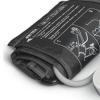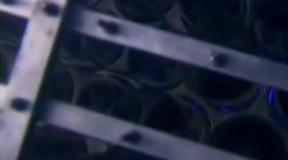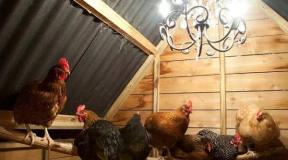How to deal with raspberry stem fly. Raspberry fly. Signs of plant damage. Pest control measures. Pest life cycle and signs of damage
I faced a similar problem twice. For the first time, I had no idea how to deal with this pest, and missed the moment.
My raspberries were on the verge of death, I had to use chemicals ... The second time I met a raspberry fly at another, new dacha. But by that time I was already well acquainted with her. In addition good people I was advised how to properly deal with this infection. And for the second time, I defeated the pest without any chemicals!
What is a raspberry fly and how to deal with it
The raspberry fly is such a small, up to 5 mm long, gray insect. To fight it effectively, you need to know the development cycle of this insect.
The female fly in the spring, somewhere in the middle of May, lays eggs in the axils of the leaves of young shoots of raspberries. After a while (after about a week), larvae appear from the eggs, which gnaw the stem and settle there, after which the tip of the young shoot withers, turns black and dries up.
If you break or cut the stem at the fold, you will see the pest's habitat there - a brown wormhole and a small white worm.
By the beginning or during the flowering of raspberries, the larva makes a move in the stem and leaves it, going into the soil for wintering. The pupa of a fly hibernates in cocoons in the upper layer of soil, at a depth of up to 6 cm, under raspberry bushes. In spring, in mid-May, a fly appears from the cocoon - its emergence coincides with the period of regrowth of young shoots.
In mid-May, the fly again lays eggs in the leaf axils, and the cycle repeats. How did I fight the stem fly?
1. Since its pupa hibernates in the upper layers of the soil at a depth of 6 cm, in autumn I dug up the ground around the raspberry bush - carefully, shallowly, so as not to damage the roots. This is necessary in order for the pupae to freeze and die in winter.
2. In early spring, the ground under the bushes was mulched with rotted manure in a layer of 8-10 cm (no less!) So that the flies that emerged from the remaining pupae could not crawl out of the thick soil layer.
3. In addition, she constantly watched; examined raspberry bushes, especially young shoots. And if she noticed a withered one, she immediately cut it off at the base, as close as possible to the roots, and burned it. If the young shoot reached a decent height in growth and it was a pity to cut it off (and, as a rule, the fly affects the very first, strongest shoots), cut off only the top of the head and examined the cut site. If she found a hole in it (a move made by the larva), she cut off the shoot up to a healthy stem that was not damaged by the larva. Then, replacement shoots grow from the sinuses of this bush, develop and bear fruit.
I made sure that the method of examining young shoots and timely removal of the affected ones (before the fly has not yet gone into the soil) is the most effective.
4. Weak, fly-damaged shoots cut out at the very root and burned. Strong, but also damaged, she left and cut off the damaged stem up to a healthy one, capturing a little healthy stem. The cut off damaged stem was burned. You can't be late with pruning!
This is how I saved the raspberry bushes. A year after these procedures, the number of affected shoots became much less, and a year later, not a single one remained! Within two years, I completely got rid of the raspberry stem fly. Currently, I spray the bushes only once, in the spring, during the ovary of green berries, with a solution of tea soda (for 10 liters of water, 2 tablespoons of soda). The berries are always clean.
Processing raspberries in spring with copper sulfate
It is important! It is necessary to spray the young shoots before the raspberry bloom and do not miss the moment when the fly larvae leave the stem and into the soil. Perhaps you missed this moment.
I have already said that when I first encountered the raspberry stem fly, I had no experience, and had to resort to chemicals. So, in the fall, after digging, I sprayed the soil under the raspberries and the bushes themselves with Bordeaux liquid.
In the spring, during the period of regrowth of raspberries, I sprayed the shoots with an insecticide. You need to spray before flowering! If you do this later, you may be late, because the fly larvae, during flowering and even before it begins, go into the soil to winter. I cut out all the affected shoots.
Below are other entries on the topic "Cottage and garden - do it yourself"
Raspberry fly brings a lot of inconvenience to gardeners and gardeners. This small insect is capable of exterminating large plantings in a short time. Plants dry up, and it is impossible to stop this process, since the insect eats the branches from the inside.
That is why this small pest is called the raspberry stem fly. The insect looks like a small midge. The body of the insect is fluffy, and a pair of transparent wings has an oblong shape. The body of an adult pest is no longer than seven millimeters in length. The fly lays eggs in flowers and raspberry buds. Of these, the larvae descend along the trunk into the ground. The pest gnaws its way in the stem. This is what causes damage to the shoots.
Gluttonous pest larvae are no more than half a centimeter long. All winter they are in cocoons, and in the spring they begin to turn into flies. It was during this period that the young grows voracious again and begins to rise from the ground into raspberry stalks. Already on the tenth day, the females of the raspberry fly are ready for breeding.
It is relatively easy to fight a pest colony, even though the fertility of the pest is high: up to 90 eggs in one clutch. How to do this and what drugs or folk ways to use for this is described in the article.
Recognizing the pest
You can recognize the sworn enemy of any raspberry by the following signs:
- Raspberry branches, or rather its young shoots, drooped.
- Small, ringing midges, which appear in the late afternoon, circle around the seedlings.
- The set berries do not grow, but at the same time they begin to blush.
As soon as at least one of the above signs showed itself, you should start processing the plant and fighting the pest. If this is not done on time, then after the raspberries are eaten, the neighboring lands will become food for the raspberry fly.

Effective control methods
The most effective methods of control and a list of the most effective drugs that can destroy or prevent the appearance of a raspberry fly in a garden plot are listed below. For convenience, they are divided into three groups:
- Insecticides are chemical and biological substances that kill insects.
- Folk compositions - infusions and natural substances, the action of which is aimed at expelling adults from the raspberry tree and scaring them away.
- Electronic insect repellents are devices that act on insects on a high-frequency wave.
Which of the options will be most suitable, should be determined by the gardener. Your choice should be based on an assessment of the benefits and harms of each individual method.

Insecticides
Insecticides used to control raspberry stem fly can be classified into contact and enteric formulations. The action of the first type of funds is aimed at eliminating adult insects. The second type of substance acts on the larvae. Modern stores also offer comprehensive all-encompassing preparations that kill both larvae and their parents.
Before using any of these drugs, you should carefully study the annotation to the drug, and also make sure that the expiration date of the drug has not passed.After using any of the above insecticides, wash your hands and face thoroughly with soap, take a shower and wash clothes.

Folk remedies
Among the verified folk ways the fight against raspberry stem fly, gardeners allocate spraying plants with a solution of ordinary baking soda. The saving liquid is prepared at the rate of two tablespoons per ten liters of water. The liquid is sprayed over the bushes and soil around the plants during the budding period, when the pest tries to settle on the plant. The manipulation can be done daily. There will be no harm to plants from soda, but flies will not land on "tasteless" raspberries.
A solution of ordinary table salt has a similar effect, but you should not abuse such spraying, because salt, getting into the ground, can burn out the roots of plants.
In addition to spraying, you can scare away the fly with wormwood mulch. From this plant, you can also prepare a bitter "tea" - a decoction, which should be watered at the root of the plant. Phytoncides will kill the larvae that have already managed to get to the roots of the plant. You can also water the soil with an infusion of red bitter pepper, prepared at the rate of three tablespoons per ten-liter bucket of water.

Scarers
To control the raspberry fly, you can use electronic devices designed to control other types of flies. Among the many devices, one should choose those that are capable of covering large areas with a signal.
The frequency that the devices emit must be adjusted precisely to expel flies, and not cockroaches, bugs or ants. Devices for fighting mice and other rodents are also not suitable for fighting a fly.
The advantages of this method of dealing with raspberry fly are:
- absolute harmlessness to warm-blooded animals and people;
- ease of use.
Also in favor of using this method is the fact that the exposure time of this device is short-term and should be turned on during the period of flies emerging for laying eggs.
The disadvantage of this method is the high cost, as well as the fact that the device is not protected from moisture. The difficulty in using a high-frequency fly repeller and in the fact that you need to closely monitor nature and guess the time when pests fly into gardens.

Preventive action
To prevent the appearance of a raspberry fly that eats stems and buds on young raspberry shoots, you can produce preventive actions... They consist in:
- Digging and loosening the area occupied by raspberries. This should be done in early spring when the snow has melted.
- Treatment with insecticides safe for bees and other means that exterminate or expel the pest. This treatment should be carried out once at a time when the mass appearance of sexually mature raspberry flies begins.
- Sanitary pruning of infected stems. It is advisable to do this during the budding period. Sick branches must be disposed of immediately. It would be best to burn them.
- Digging the soil and processing it with a mixture of Bordeaux from a spray bottle. Actions should be performed during the period of juice stoppage, which happens in late autumn. In the event that the affected area had a large area, plants should be treated with "Karbaphos" or another long-acting insecticide.
- Thinning plantings and timely harvesting of fallen leaves.
In order to avoid attracting a raspberry fly to your site, remember some generally accepted rules and avoid breaking them in every possible way. They are listed below:
- compost heaps should be equipped far from the beds;
- plants should receive regular fertilizing with minerals;
- for the winter, peat or compost should be scattered over the raspberries.
Preventive measures to combat the stem pest should be carried out annually, even if the raspberry fly has not shown itself on the raspberry bushes. And all because this pest can take a liking to fresh plantings and fly from a neighboring area, where there are no more raspberries.
In conclusion, I would like to say that all methods of dealing with raspberry fly are simple to perform. Following the recommendations given in the article, you can preserve the health of the raspberry tree and, as a reward, get an excellent harvest of sweet, vitamin and aromatic berries.

The raspberry stem fly is dangerous primarily in that it destroys young shoots, on which many tasty berries could grow in the future. In some years, the number of this pest increases so much that the yield of the raspberry plantation is halved from its activity! What is this small but so harmful insect and how to deal with it?
Flies crawl out of their winter shelter, located in the upper arable layer under raspberry plants, at a time when young shoots appear next to the bushes. Typically, this event occurs in mid-May. Pest females lay their eggs in leaf axils (one egg at each leaf base) in the upper parts of such shoots. The larvae that have developed from the eggs penetrate the stem and make a long spiral-circular tunnel in it. Moreover, their passages can stretch to the very base of the stem!
As a result, the tops of young stems wither, fall off, and then completely darken and die. During the period of separation of buds and flowering of raspberry bushes, the larvae are selected from the shoots and buried in the ground for the winter.
Raspberry stem fly control methods
 It is very easy to detect traces of the destructive activity of the larvae of this insect - if you notice fresh shoots in the raspberry with dropping, blackening tops, then most likely your plants are attacked by the raspberry stem fly.
It is very easy to detect traces of the destructive activity of the larvae of this insect - if you notice fresh shoots in the raspberry with dropping, blackening tops, then most likely your plants are attacked by the raspberry stem fly.
If one of these shoots is broken, then you will see a blue ring, inside which tiny pale legless larvae will wriggle in the gnawed passages.
As soon as the height of diseased shoots reaches 10-15 centimeters, they must be cut and destroyed (for example, burned at the stake). Of course, if there is a lot of pest, then such a cardinal pruning is fraught with the loss of most of the crop. In this case, it makes sense to slightly change the method of shortening damaged shoots.
The strongest and most developed shoots mainly suffer from flies - they do not need to be cut out at the base, but simply to remove the part infected with the fly to healthy tissue. Subsequently, on the left part of the shoot, from 2 to 3 sufficiently powerful lateral shoots begin to form gradually. The replacement shoots develop well and produce a decent amount of berries.
Weak shoots with signs of damage by a raspberry stem fly, of course, must be cut right under the very root. And do not delay this work - the larvae can have time to go into the soil, and next year flies will hatch from it and again damage the young branches of raspberries.
To get rid of the invasion of pests in the bud formation phase, fruiting branches are treated with a 0.1% solution of fufanon (or novaktion, actellik according to the instructions) or a drug called a spark (one tablet per ten liters of water). Of the folk methods of struggle, infusions of onion husks, tobacco, garlic, etc. have proven themselves well.
Another effective remedy for the destruction of raspberry stem fly is an aqueous solution of chlorophos (20 grams per 10 liters of water). The solution consumption is approximately two liters per 10 adult plants. The bushes and the soil under them are generously sprayed in the phase of the mass summer of flies.
In order to exterminate the insects hiding for the winter, one must also not neglect the autumn cultivation of the soil under the bushes with one of the above preparations.
With the beginning of spring, in April - May, young shoots of raspberries begin to grow. However, among the young strong stems, you notice withered, bent tips of the shoots. Many gardeners think that this is from a lack of moisture or some kind of plant disease. In fact, it is a raspberry fly. The danger from being close to a pest is that the fly lays its larva inside the stem. Subsequently, it leads to the death of the plant. How to deal with a raspberry fly and is it possible, in more detail in the article.
Raspberry fly is a small insect no more than 6-7 mm of gray-brown color. How she looks, look at the photo.

What is the harm from a raspberry fly
The fly itself does not do much harm to the shoots, but the larvae laid by it pose a great danger to the plant. It strikes the very first, strongest shoots. A raspberry stem fly pierces a young stem in the upper part of it and lays eggs there. A puncture is sometimes difficult to see, it is rather small, but looking closer you can see a hole, and around an unhealthy dark fabric.
After 5-8 days, larvae develop from the eggs, small white oval worms up to 2-3 mm in size. The larva begins to move down the stem, eating up the middle of the stem. Naturally, the nutrition of the tops is disrupted. First, the leaves hang on the shoot, wither, and later the shoot dries up and dies. If you break the stalk, then you can see a maggot - a worm, as in this photo.

To winter, the larvae go to the upper layers of the soil, where they pupate, and with the onset of warmth in early spring, a new generation of flies crawls out of the ground. One fly can lay up to 90 eggs per season.
Effects
As a rule, a fly affects more than one shoot, but several. And if you do not take any control measures, then the raspberry tree will degenerate over time, since the fly affects only healthy strong shoots. And on weak, immature, you can hardly get a good harvest of berries.
What contributes to the appearance of raspberry flies?
- Thickened poorly ventilated planting of bushes;
- A large number of aphids, which produce honeydew, attracting raspberry flies;
- Plant residues under bushes in which the larvae overwinter well;
- The fly can get into the soil along with the humus, which is used to mulch the soil under the raspberry bushes;
- Bushes of meadowsweet, meadowsweet, blackberry growing next to raspberries, in which the raspberry fly also lives.
Control measures
In the fight against flies, chemical, biological and folk remedies are used.
Insecticides
Chemicals are used both for prophylactic purposes and for controlling the fly. It is important to remember that insecticide treatment is carried out in calm weather, preferably in the morning or evening, when the sun is not high. Processing can be carried out during the day, but in cloudy weather. Such restrictions are necessary so that after processing, sunburn does not form on the fragile leaves. Of course, such preparations should not be used before rain.
Working solutions of these products are used to treat leaves and stems from flies and the soil under bushes to destroy the larvae.

For processing, you can use the following tools:
- Karbofos - moderately toxic drug, for use 60 g of the product is diluted in 1 bucket of water. It is necessary to be careful if hives are nearby, as the drug has a detrimental effect on bees;
- Spark - a drug with a wide spectrum of action, including against the raspberry fly. 1 tablet of the product is diluted in 10 liters of water;
- Atellik - sold in ampoules of 2 ml and in cans of 5 liters. Before diluting the product, you must follow the instructions for use. Due to the strong toxicity of the drug, it can be used no more than two times per season;
- Conifor - a highly effective, low-toxic agent, during treatment seeps through the surface of leaves, stems, roots. Protects the plant from flies for two weeks, so re-treatments are required.
- Fufanon-nova - an effective systemic insecticide, The solution is induced according to the instructions, 1 ampoule is diluted with 5.5 liters of water.
All insecticides are poisonous, therefore, when working with them, you must be careful, wear protective clothing, glasses, gloves.
Biological preparations
- Fitoverm - the drug acts on a large number of flying insects. The effect occurs when the drug has entered the gastrointestinal tract of an insect, and does not affect the larvae and pupae, since they do not feed. This remedy is safe for bees. The drug is bred according to the instructions, the leaves and crown of bushes and trees are treated. After guidance, the solution must be used immediately. Harvesting can be carried out no earlier than 2 days later.
- Agravertine - alcohol extract of streptomyces soil fungus. Getting into the gastrointestinal tract of the insect after 12 hours, the drug begins to act, paralyzing the insect and causing its death after 3 days. The solution is guided according to the instructions and used immediately after it is guided. The drug is especially effective in hot weather.
Folk remedies and care for the raspberry tree
Correct and timely will not give the opportunity to lay the larvae in the stems and deprive the larvae of the opportunity to develop in the soil. What is raspberry care?
- As soon as the first shoots begin to appear, inspect the raspberry tree once a week. Seeing withered young shoots, you must immediately cut them out and be sure to burn them. Cut the stem at ground level and even burrowing a little into the ground;
- To scare off flies, the bushes are irrigated with a solution of baking soda (2 tablespoons per bucket of water) and irrigated before the berries begin to set. For this purpose, someone sprays the bushes with a mustard solution, which also helps;
- To prevent the raspberry fly from laying eggs, it is necessary that adults do not hatch from the larvae in the spring. For this purpose, mulching is carried out with a layer of at least 8 cm. Plant residues, peat, sawdust are used as mulch;
- Remove old branches and young weak growth in time. They take over useful material, the return on them will be minimal. The remaining young stems will take up more nutrients, grow stronger faster and better cope with pests and diseases. In addition, thickened raspberries are an ideal environment for flies;
- Treat the raspberry plant in advance with biological preparations, they are harmless and effective, they act on other pests, but they are safe for bees;
- In the fall, after harvesting, collect the screeching foliage, loosen the soil under the bushes, in the loose earth the pupae will freeze faster in winter. Loosen the soil carefully so as not to damage the root system. You can treat the soil with some kind of insecticide.
Do not forget to feed the bushes in the spring, then in the summer they will delight you with an abundant harvest of sweet berries.
Here you can order the most productive varieties of raspberries
– the favorite berry culture of many gardeners. Juicy berries are valued not only for their excellent taste, but are also famous for their useful properties... The fruits of the plant have anti-inflammatory, antipyretic effects, increase the tone of the body and give energy, help fight stress. However, to grow successfully, you need to know how to effectively counter raspberry pests.
Did you know? In the American city of Enterprise, a monument was erected to one of the pests of raspberries and other plants - the weevil beetle. The fact is that having destroyed all cotton in 1915, he forced the farmers to plant new crops. Thus, a multifaceted economy developed.
Gall midges
The raspberry gall midge (raspberry gnat) is the most dangerous pest of this culture. In the spring, insects lay their eggs in crevices in the bark of the plant. They develop white larvae. While feeding, the larvae secrete toxic substances that cause the formation of galls - swelling, and the bark is strongly cracked.

Raspberry growth slows down due to damage, shoots dry up and break under strong gusts of wind. Over time, the larvae land on the ground, turn into cocoons and grow into adult insects. Three pest development cycles can pass in one season.
To combat it, it is necessary in the summer, when there are most larvae, to destroy the infected shoots. It is also recommended to spray the soil under the bushes twice with a 0.15-0.3% chlorophos solution. The first time this is done when the soil warms up to +13 ° C, before the insects fly out, again - 10 days after the first spraying.
Raspberry stem gall midge
A small fly in May-June lays eggs near raspberry buds. The hatched larvae begin to feed on the sap of the plant, disrupting its normal development. Galls are formed in places where the larvae accumulate. Where these seals appear, the bark cracks and separates from the branch. The larvae pupate right in the gall and the cycle continues.
The fight against stem gall midge on raspberries occurs with the help of:
- scrupulous selection planting material, no signs of infection;
- thorough destruction of all damaged branches;
- spraying raspberries with chemicals twice a year (in spring, before laying insect eggs and in autumn, after harvesting and digging the soil). To do this, use 1% Bordeaux liquid or karbofos emulsion (0.1-0.2%).
 With the arrival of the first spring heat, immature beetles begin to eat young raspberry leaves, and with the appearance of buds, anthers from flowers. Then the female lays eggs in a bud, gnaws at it, and the further development of the pest takes place in the fallen inflorescence.
With the arrival of the first spring heat, immature beetles begin to eat young raspberry leaves, and with the appearance of buds, anthers from flowers. Then the female lays eggs in a bud, gnaws at it, and the further development of the pest takes place in the fallen inflorescence.
Did you know? One female weevil lays up to 50 eggs.
The larva feeds on the bud, pupates and eventually turns into an adult insect. The cycle repeats itself. Infection with strawberry-raspberry weevil can be identified by small holes in young raspberry leaves, bud fall and the presence of larvae in them.
Experienced gardeners advise the following methods to protect raspberries from this pest:
- agrotechnical: digging or autumn plowing of the soil under the bushes;
- mechanical: destruction of fallen leaves and buds, shaking off beetles from the plant;
- biological: planting strong-smelling plants between raspberry bushes (garlic, onion, tansy, celandine, mustard, paprika, etc.);
- chemical: spraying the plant before and after flowering with "Fufafon" preparations (15 ml of the substance is dissolved in 5 liters of water; consumption - 5 liters of solution per 10 m²), "Kemifos" (10 ml of the drug is added to 10 liters of water; consumption - 1.5 liters of solution per 10 m²), "Alatar" (5 ml of the drug is dissolved in 4 liters of water; consumption - 4 liters of solution per 100 m²).
Important! In order to avoid weevil infestation, it is not recommended to plant raspberries and strawberries close to each other.
Mites
 This pest can attack raspberries in dry and hot weather. He lives on the underside of the leaves and entangles them with cobwebs. It feeds on plant sap. As a result of infection, white spots appear on the leaves, and over time they completely dry out. You can fight a tick on raspberries in the following ways:
This pest can attack raspberries in dry and hot weather. He lives on the underside of the leaves and entangles them with cobwebs. It feeds on plant sap. As a result of infection, white spots appear on the leaves, and over time they completely dry out. You can fight a tick on raspberries in the following ways:
- applying watering to bushes and soil under them in hot weather;
- spraying the plant according to the instructions using drugs such as colloidal sulfur, malofos, cydial, phosphamide, metaphos. If necessary, the treatment with chemicals is repeated several times, with an interval of 10 days.
Important! Water the raspberries at dawn or in the evening, after sunset, to avoid rapid evaporation of moisture.
Raspberry mite
The female pest hibernates under the upper shell of the kidney.During the period of leaf blooming, the mites come out of the shelter and begin to feed on the sap of the plant. At the same time, the leaves bend and brighten, the bushes grow poorly.
To prevent infection and control raspberry mite, after flowering and harvesting, it is recommended to spray the plant with karbofos. Insecticides "Aktellik", "Fufafon", "Iskra M" are used.
 The insect hibernates at a depth of 5-10 cm in the soil. In spring it climbs on blossoming raspberry flowers, lays eggs, from which larvae develop, and eats buds. The larvae return to the ground to pupate and turn into adult insects next spring. The cycle repeats itself.
The insect hibernates at a depth of 5-10 cm in the soil. In spring it climbs on blossoming raspberry flowers, lays eggs, from which larvae develop, and eats buds. The larvae return to the ground to pupate and turn into adult insects next spring. The cycle repeats itself.
In the war with the raspberry beetle, the following methods of struggle are used:
- digging up the soil under the plants and in the aisles during the formation of insect pupae;
- spraying with decis, confidor, karbofos.
Raspberry kidney moth
It is especially harmful to early raspberry varieties. Caterpillars hibernate in cracks in the bark of shoots or under plants in fallen leaves. In the spring, they gnaw the buds of the plant and pupate there. Dark brown butterflies emerge from pupae and lay eggs in flowers. Hatched caterpillars eat ripe berries
To get rid of raspberry kidney moth you need:
- when pruning old branches, make sure that there are no hemp left;
- as soon as the buds begin to swell, treat the raspberry with Iskra, Confidor, Decis or Karbofos.

The larvae of the pest, feeding on the juice from the stalks of raspberries, cause cracking and swelling of the bark. Damaged branches bear little fruit, break and dry out. It differs from the stem gall midge only in the size of the seals, which can reach up to 10 cm in length. Apply the same control measures as with the previous pests.
Raspberry stem fly
L insect eggs gnaw spiral holes inside the stem, which is why the tops of raspberries begin to quickly wither and turn black, and then rot. At the beginning of flowering, the larvae go into the soil for the winter, where they turn into butterflies that lay eggs. The hatched caterpillars begin to spoil the branches from the inside again.
In the case of the raspberry stem fly, the following control methods are used:
- digging up the soil in autumn and harvesting fallen leaves;
- processing culture in early spring (as soon as young shoots appear), with the help of "Karbofos" or "Aktelliki".
 In mid-summer, butterflies lay their eggs in the soil at the base of the raspberry shoots. The white caterpillars that have emerged from them begin to bite into the branches, which is why swelling appears. They hibernate and pupate right in the stems of the plant. The next year, the pupae turn into butterflies and the cycle repeats. Raspberry contaminated with glass withers and dries quickly.
In mid-summer, butterflies lay their eggs in the soil at the base of the raspberry shoots. The white caterpillars that have emerged from them begin to bite into the branches, which is why swelling appears. They hibernate and pupate right in the stems of the plant. The next year, the pupae turn into butterflies and the cycle repeats. Raspberry contaminated with glass withers and dries quickly.
Read also ...
- Water ionizer - how to choose?
- Does the belly massager help with weight loss El slimming massager with hands
- Cheerful nebulizer Kit: advantages and disadvantages, analogues
- Body massager VitaImpuls manual electric vibration massage apparatus with thermal radiation Vita Impulse Show instructions vita impulse with heat



















